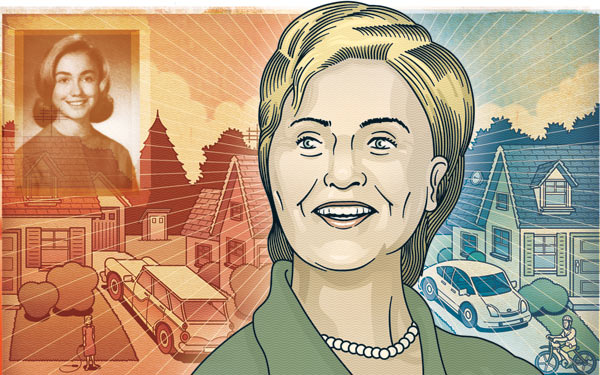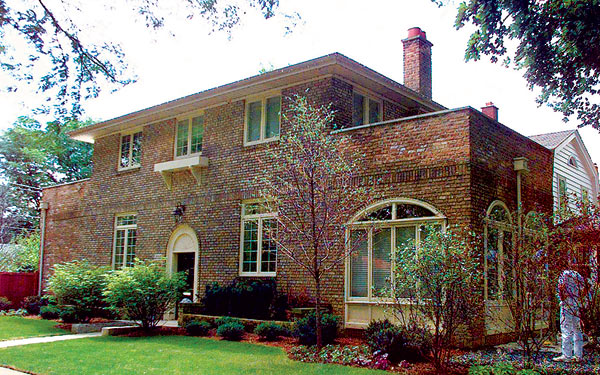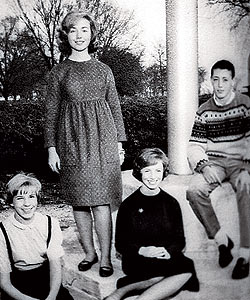
In the fall of 1964, two high-school girls from Park Ridge—Hillary Rodham and her best friend, Betsy Johnson—developed a crush on the same man. His name was Barry Goldwater, and he was the Republican nominee for president.
Today, Hillary Rodham Clinton and the Republican Party have little use for each other. But that campaign season, it was hard to find anyone more devoted to Goldwater's hopeless cause, even in conservative Park Ridge. Hillary chaired Young Republican meetings in Betsy's basement, and dressed as a Goldwater Girl, wearing a cowboy outfit and a ten-gallon hat adorned with the candidate's catchphrase—AuH2O. "We actually set up the Youth for Goldwater headquarters in Park Ridge," recalls Betsy Johnson, now Betsy Ebeling. "It was right downtown. I remember my sister brought in her sewing machine and sewed red, white, and blue bunting."
Hillary had been turned on to Goldwater by one of her first political mentors, a conservative-leaning history teacher who encouraged her to read The Conscience of a Conservative, the Arizona senator's campaign biography. Her youthful infatuation with the Republican Party was reinforced by her father, a crusty, fiscally conservative draper who was so tight with money he paid for the family house in cash and refused to give his children an allowance. In 1960, Hugh Rodham supported Richard M. Nixon for president, and so did his 13-year-old daughter.
Even as a teenager, Hillary was intensely interested in politics. And in Park Ridge, in the early 1960s, politics meant the Republican Party. Set just beyond Chicago's Northwest Side, Park Ridge was a train-station Cook County suburb, almost uniformly white, Protestant, and professional. While it wasn't as tony as the North Shore, it was full of young strivers fleeing grimy, crowded, corrupt Chicago. Hillary's parents, Hugh and Dorothy Rodham, moved there in 1950 from the city's North Side. Perhaps foreshadowing the genteel aspirations of its future residents, in 1873 Park Ridge had changed its name from the earthier, urban-sounding Brickton. "The town was very conservative," remembers Kathy Burgess, who as Kathy Rodgers sat next to Hillary in homeroom at Maine East High School. "There was a big Republican organization there. I can't remember anything about Democrats at all."
Yet Hillary's journey from Republican to Democrat hasn't made her a turncoat to her hometown's values. It's made her a pioneer. The suburb that was once an exemplar of Chicago Tribune-Eisenhower Midwestern Republicanism is now turning Democratic. And Hillary didn't just presage the change. She helped make it happen. Maine Township, which includes Park Ridge, Niles, and Des Plaines, began voting Democratic for president in 1996—when Hillary's husband, Bill, was running for reelection. It hasn't gone Republican since. The Democratic trend has been repeated all over the Cook County suburbs and is happening in the collar counties, too. Not to mention Illinois as a whole, which has become a reliably blue state in recent presidential and statewide elections.

In the first three decades after Hillary Rodham left for college and moved squarely into the Democratic camp, Park Ridge didn't change much politically. Throughout the 1970s and '80s, the town was still dominated by old-fashioned Republicans of the vintage of Hillary's father. Maine Township voted enthusiastically for Richard Nixon, Ronald Reagan, and George H. W. Bush. Russ Stewart, a Park Ridge attorney, writes a political column for Nadig Newspapers, a chain of Northwest Side weeklies. When he began practicing law in 1979, "everybody here was in their 50s and 60s—older people, Goldwater Republicans." But those old voters have moved to Florida or the Town of Maine cemetery. They're being replaced by young couples who voted Democratic when they were Lake View singles and aren't about to let marriage or the suburbs change their views. The change has been swift. In 1984, Reagan won Maine Township with 71 percent of the vote. Four years later, Bush got 63 percent. Bill Clinton came within 2,500 votes of winning in 1992, and then painted the township blue during his reelection bid. "In another five years, Park Ridge will be like Oak Park," Stewart predicts. "When I walk around on Saturday morning, I see these young couples with their dogs, getting coffee, and they're social liberals."
Just like their hometown's favorite daughter.
The chaotic year of 1968 turned American politics upside down. It confirmed Hillary's liberal beliefs and set the stage for suburbia's eventual transformation three decades later. That winter, Hillary campaigned for Minnesota's dovish senator Eugene McCarthy. Nonetheless, when she applied for a Washington internship, her thesis adviser at Wellesley College assigned her to the House Republican Conference. At the GOP convention in Miami, Hillary staffed a Nelson Rockefeller for President suite and was appalled by the nomination of Richard Nixon, who was hustling votes of Southern conservatives. She was just as taken aback by the Democratic convention in Chicago, which she and Betsy Ebeling witnessed firsthand, sneaking down to Grant Park by telling their parents they were going to a movie. Although she was no rebel, Hillary was shocked by the police brutality they saw and became convinced of the need for peaceful change. When she returned to Wellesley, Hillary decided to write her senior thesis on Saul Alinsky, the radical Chicago community organizer. "What that meant was that she was vitally interested in the problems of poor people," says her former college adviser, Alan Schechter. "Republicans are traditionally not interested in spending tax money on the problems of poor people," he says. "By that September, she had made up her mind."

In some ways, the young people moving into Park Ridge aren't much different from the Rodhams of 1950: They're professionals, moving into their first houses, starting families. The median household income in Park Ridge is more than $80,000, about twice Chicago's. And Park Ridge is still 95 percent white. Politically, though, they couldn't have less in common with the gruff conservatives: Most are pro-choice, pro-gun control, and pro-government, willing to tax themselves for schools and libraries. These newcomers may have migrated to the suburbs from Chicago, but unlike their World War II-veteran forebears, they didn't shed their city values as a sign of upward mobility. The older pattern was, you moved to the suburbs when you could afford it and often became a Republican like your neighbors, observes the Chicago political consultant Don Rose. "The move to the suburbs is no longer only based on your rise in income," he says. "It's not as much of a status symbol. Your political choices do not seem as totally tied to your economic status as they once were. You can earn $200,000 a year and be a Democrat."
The Clinton Administration's moderate politics—signing NAFTA and reforming welfare—helped make these well-to-do white homeowners comfortable with the Democratic Party, says Park Ridge's Russ Stewart. "They were just a bridge from the party of Humphrey and Mondale and Dukakis, which was deemed as being a party of minorities," he says. "They put a new face on it, where taxes are not taxes; they're investments." Because they balanced the federal budget, the Clintons were also seen as fiscally responsible, a timeless suburban value. Ruy Teixeira, coauthor of The Emerging Democratic Majority, identifies the Chicago area as an "ideopolis" whose professionals benefited from the prosperity of the Clinton years, especially the shift from a manufacturing economy to a knowledge-based economy. As a result, suburban Cook County has become "irretrievably Democratic," Teixeira says. The change in suburban voting patterns has even spread to the collar counties. Look at Lake County. It was once a rural preserve of dairy farms, resort cottages, and WASPy North Shore enclaves. Only Waukegan, North Chicago, Buffalo Grove, and Highland Park—with its significant Jewish vote—were Democratic. The party didn't elect its first countywide official until 1970. But as urbanization began creeping up from Chicago, so did Democratic vote totals. It is now the state's quintessential swing county. In 1996, Bill Clinton won Lake County by 166 votes. The county voted twice for George W. Bush (he squeaked by with 49.9 percent in 2000, and 50.5 percent in 2004), but it dumped the archconservative congressman Philip Crane in 2004, replacing him with Democrat Melissa Bean. Three of its five state senators are Democrats, contributing to the party's 37-22 majority in a body that was controlled by Republicans just six years ago. "These people are moving out to Lake County, and the realtor never told 'em they had to vote Republican," says Pete Couvall, vice-chair of the Lake County Democratic Party. Couvall says voters were also turned off by the stridency of the Republican Right, especially its attacks on Bill Clinton. When the Republican Party was dominated by moderates from Midwestern and Northeastern states, it won Illinois comfortably. Once the party was captured by conservative ideologues, Illinoisans shied away. Hillary saw the first stirrings of this movement as a college student at the 1968 GOP convention. It reached its apotheosis in 1994, when Republicans took over Congress. "Newt Gingrich was the best friend we ever had," Couvall says. "His conservative views, his hypocritical views, what he did to the president."
The bluish line in Chicago's suburbs has changed the tint of the state at large. Illinois politics was once marked by the competition between Democratic Chicago and its Republican suburbs. Downstate held the balance of power. In six successive elections, from 1968 to 1988, Illinois voted Republican for president. Since the early 1990s came along, the political line between city and suburb has been erased, and the state has been reliably Democratic.
While the Clintons helped set the trend in motion, the election that confirmed the Democrats' ascendancy in Park Ridge took place in 2006, when Dan Kotowski, an antigun crusader with roots in Chicago, won the 33rd district state senate seat. Kotowski is the town's first Democratic state senator since before the Civil War. He defeated a Republican state senator, Cheryl Axley, by presenting himself as a middle-of-the-road Democrat—"fiscally accountable and socially progressive"—a description that could have fit the Rockefeller Republicans, Hillary Clinton's last stop in the GOP. A tireless bellringer, Kotowski says he found disenchantment with the Republican Party behind door after door on his trips around the district. "I can't even tell you the number of people who told me they would never vote Republican again," he says. "I talked to a guy who said he voted Republican in the last presidential election. He said, 'I made a mistake.'"
That's something a young Goldwater Girl, going door to door in 1964, would never have heard.



